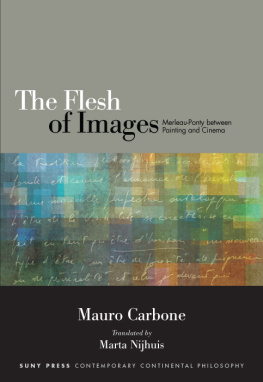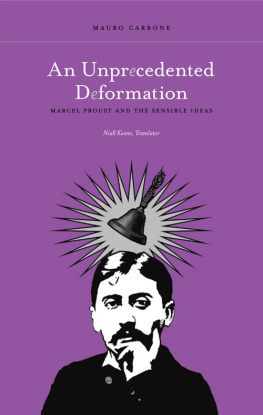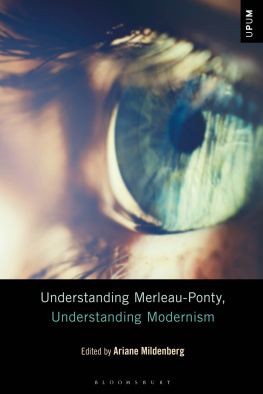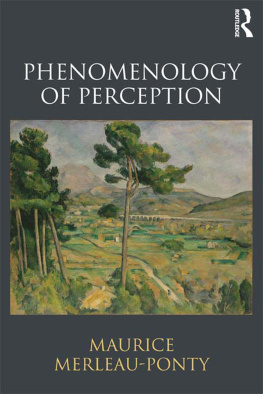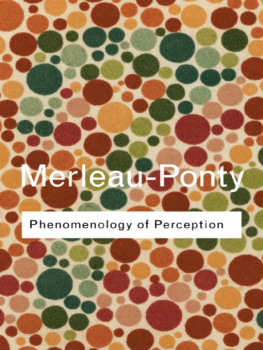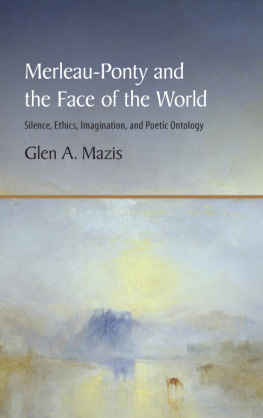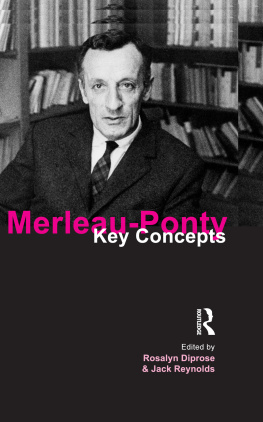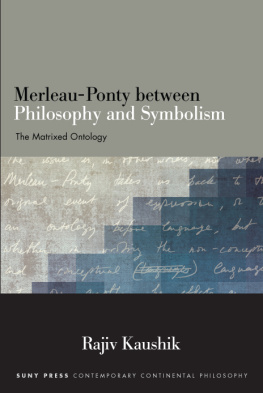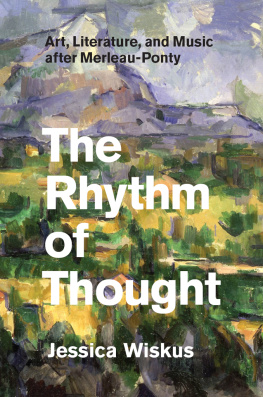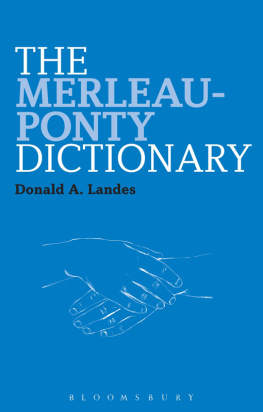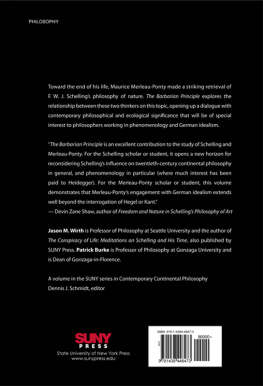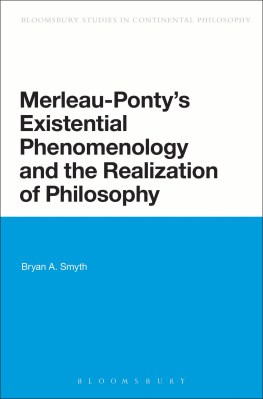The Flesh of Images
SUNY series in Contemporary Continental Philosophy
Dennis J. Schmidt, editor
The Flesh of Images
Merleau-Ponty between Painting and Cinema
Mauro Carbone
Translated by Marta Nijhuis
Published by State University of New York Press, Albany
La chair des images: Merleau-Ponty entre peinture et cinma
Librairie Philosophique J. Vrin, Paris, 2011.
http://www.vrin.fr
2015 State University of New York
All rights reserved
Printed in the United States of America
No part of this book may be used or reproduced in any manner whatsoever without written permission. No part of this book may be stored in a retrieval system or transmitted in any form or by any means including electronic, electrostatic, magnetic tape, mechanical, photocopying, recording, or otherwise without the prior permission in writing of the publisher.
For information, contact State University of New York Press, Albany, NY
www.sunypress.edu
Production, Ryan Morris
Marketing, Anne M. Valentine
Library of Congress Cataloging-in-Publication Data
Carbone, Mauro, 1956 author.
[Chair des images. English]
The flesh of images : Merleau-Ponty between painting and cinema / Mauro
Carbone ; Translated by Marta Nijhuis.
pages cm. (SUNY series in contemporary continental philosophy)
Includes bibliographical references and index.
ISBN 978-1-4384-5879-3 (hardcover : alk. paper)
ISBN 978-1-4384-5880-9 (e-book)
1. Merleau-Ponty, Maurice, 19081961KnowledgePainting. 2. Merleau-Ponty, Maurice, 19081961KnowledgeMotion pictures. 3. Painting. 4. Motion pictures. I. Nijhuis, Marta, 1983 translator. II. Carbone, Mauro, 1956Chair des images. Translation of: III. Title.
| B2430.M3764C373313 2015 |
| 121.34dc23 | 2015001352 |
10 9 8 7 6 5 4 3 2 1
Contents
I NTRODUCTION
The Flesh and the Thinking of the Visual Today
C HAPTER O NE
Flesh: Toward the History of a Misunderstanding
C HAPTER T WO
It Takes a Long Time to Become Wild: Gauguin According to Merleau-Ponty, Merleau-Ponty According to Gauguin
C HAPTER T HREE
Making Visible: Merleau-Ponty and Paul Klee
C HAPTER F OUR
The Philosopher and the Moviemaker: Merleau-Ponty and Cinematic Thinking
C HAPTER F IVE
The Light of the Flesh: Anti-Platonistic Instances and Neoplatonic Traces in the Later Merleau-Pontys Thinking
C HAPTER S IX
The Sensible Ideas Between Life and Philosophy
Acknowledgments
The present book is the other side of my previous work An Unprecedented Deformation: Marcel Proust and the Sensible Ideas (Albany: SUNY 2010), which presented some elements for a new conception of ideas. This book, for its part, aims at contributing to a reflection on the current status of images precisely meant as the ideas sensible side.
This is the reason why I would like to thank Denny Schmidt for also welcoming this work into his series. I am likewise proud and grateful to mention that my appointment to the Institut Universitaire de France helped to financially support the accomplishment of this publication project.
Initial versions of some of this books chapters have previously appeared in collective works or journals. I would, hence, like to thank the translators of those versions and the editors of those works and journals. My gratitude also goes to other colleagues and friends, who have all played an important role in the development of this work: Dudley Andrew, Giovanna Borradori, Francesco Casetti, Donatella Di Cesare, Duane Davis, Galen Johnson, Len Lawlor, Matt Tugby, and Emmanuel de Saint Aubert.
This book is for Marta, for everything is ultimately thanks to her.
Introduction
The Flesh and the Thinking of the Visual Today
It is well known that the notion of flesh is at the very core of Merleau-Pontys later reflection. However, what is often forgotten is that flesh is another name for the element he also calls Visibility. The latter thus appears as a texture of differentiations, in which the visible is always interweaved with an invisible that is indirectly shown by the visible itself.
Hence, considering these characterizations, the element of Visibility appears, on the one hand, as a challenge toward the categories on which the Western philosophical tradition is based, and on the other hand, as the announcement of the opening of a new ontological perspective. Indeed, the being of Visibility is characterized as horizon being: a new type of being, a being by porosity, pregnancy, or generality, and he before whom the horizon opens is caught up, included within it. This thesis also shows how he conceived our corporeity from the standpoint of theexperience of the flesh of the worldnamely, the experience of Visibilityjust as he had conceived the latter from the standpoint of the first.
For these and more reasons, the present writing is based on a double conviction. On the one hand, characterizing Merleau-Pontys notion of flesh by that of Visibility allows us to avoid most misunderstandings related to the interpretation of the first. On the other hand, it allowed Merleau-Ponty himself to elaborate extremely innovative ontological notions, which can help us to consider philosophically some of todays most significant cultural phenomena.
Amid such cultural phenomena, our new relationship to images is emblematic. In fact, it is well known that the ongoing development of optical and media technologies keeps opening our existences to new forms of visualization and visual experience. This implies a new centrality of images, not only practically and professionally, but also theoretically. Precisely on this basis, since the 1990s, an iconic (or pictorial) turn (also called ikonische Wende) was evoked in our culture, imposing a renewed analysis of the contemporary status of images.
Indeed, the mutations at work in the images status seem to evokeand to invoke at oncea form of reversal of Platonism. By developing the premises affirmed by Nietzsches philosophy image denounces the Platonism underlying the opinion that too willingly associates it with death.
More generally, if the image is not a second thing, then it can no longer be qualified as a simple figure of reference, as I will try to show in certain passages of the present work. Indeed, the nature of such a reference gets complicated, and its structure multiplies and becomes so entangled that the first thing back to which that reference is supposed to leadthat is, the absence it is supposed to presentifyends up being untraceable.
The counterpart of such a status of the image is that of seeing, according to the definition elaborated by Merleau-Ponty in the Introduction to Signs, which is coeval with the writings I mentioned so far: To see is as a matter of principle to see farther than one sees, to reach a latent existence. The invisible is the outline and the depth of the visible. The visible does not admit of pure positivity any more than the invisible does.
It is clear that the seeing Merleau-Ponty tries to characterize by this formulation is no longer conceived according to the representative model of the window, which has become dominant in the Western culture since the Renaissance.
Hence, the seeing farther than one seesunderstood precisely as a seeing according to, or with what one seesis underlaid by the efficient and insistent latency of a dimension which the later Merleau-Ponty often qualifies as mythical, featuring some most peculiar spatio-temporal dynamics and unexplored ontological implications. In short: it is in this sense that the element he called Visibility can also be called flesh. In fact, [b]etween the alleged colors and visibles, we would find anew the tissue that lines them, sustains them, nourishes them, and which for its part is not a thing, but a possibility, a latency, and a

